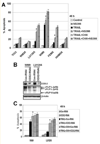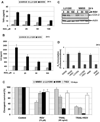Suppression of the proinflammatory response of metastatic melanoma cells increases TRAIL-induced apoptosis
- PMID: 21268068
- PMCID: PMC4378843
- DOI: 10.1002/jcb.22934
Suppression of the proinflammatory response of metastatic melanoma cells increases TRAIL-induced apoptosis
Abstract
Melanoma is the most lethal form of human skin cancer. However, only limited chemotherapy is currently available for the metastatic stage of the disease. Since chemotherapy, radiation and sodium arsenite treatment operate mainly through induction of the intrinsic mitochondrial pathway, a strongly decreased mitochondrial function in metastatic melanoma cells, could be responsible for low efficacy of the conventional therapy of melanoma. Another feature of metastatic melanoma cells is their proinflammatory phenotype, linked to endogenous expression of the inflammatory cytokines, such as TNFα IL6 and IL8, their receptors, and constitutive NF-κB- and STAT3-dependent gene expression, including cyclooxygenase-2 (PTGS2/COX2). In the present study, we treated melanoma cells with immunological (monoclonal antibody against TNFα or IL6), pharmacological (small molecular inhibitors of IKKβ-NF-κB and JAK2-STAT3) or genetic (specific RNAi for COX-2) agents that suppressed the inflammatory response in combination with induction of apoptosis via TRAIL. As a result of these combined treatments, exogenous TRAIL via interactions with TRAIL-R2/R1 strongly increased levels of apoptosis in resistant melanoma cells. The present study provides new understanding of the regulation of TRAIL-mediated apoptosis in melanoma and will serve as the foundation for the potential development of a novel approach for a therapy of resistant melanomas.
Copyright © 2010 Wiley-Liss, Inc.
Figures







Similar articles
-
Radiation response and regulation of apoptosis induced by a combination of TRAIL and CHX in cells lacking mitochondrial DNA: a role for NF-κB-STAT3-directed gene expression.Exp Cell Res. 2011 Jul 1;317(11):1548-66. doi: 10.1016/j.yexcr.2011.03.012. Epub 2011 Apr 2. Exp Cell Res. 2011. PMID: 21440540 Free PMC article.
-
Sodium arsenite accelerates TRAIL-mediated apoptosis in melanoma cells through upregulation of TRAIL-R1/R2 surface levels and downregulation of cFLIP expression.Exp Cell Res. 2006 Dec 10;312(20):4120-38. doi: 10.1016/j.yexcr.2006.09.019. Epub 2006 Sep 28. Exp Cell Res. 2006. PMID: 17070520 Free PMC article.
-
Inhibition of ataxia telangiectasia mutated kinase activity enhances TRAIL-mediated apoptosis in human melanoma cells.Cancer Res. 2009 Apr 15;69(8):3510-9. doi: 10.1158/0008-5472.CAN-08-3883. Epub 2009 Apr 7. Cancer Res. 2009. PMID: 19351839 Free PMC article.
-
Resveratrol sensitizes melanomas to TRAIL through modulation of antiapoptotic gene expression.Exp Cell Res. 2008 Mar 10;314(5):1163-76. doi: 10.1016/j.yexcr.2007.12.012. Epub 2007 Dec 23. Exp Cell Res. 2008. PMID: 18222423 Free PMC article.
-
Targeting TNF-related apoptosis-inducing ligand (TRAIL) receptor by natural products as a potential therapeutic approach for cancer therapy.Exp Biol Med (Maywood). 2015 Jun;240(6):760-73. doi: 10.1177/1535370215579167. Epub 2015 Apr 7. Exp Biol Med (Maywood). 2015. PMID: 25854879 Free PMC article. Review.
Cited by
-
Regulation of viability, differentiation and death of human melanoma cells carrying neural stem cell biomarkers: a possibility for neural trans-differentiation.Apoptosis. 2015 Jul;20(7):996-1015. doi: 10.1007/s10495-015-1131-3. Apoptosis. 2015. PMID: 25953317 Free PMC article.
-
An in-silico study examining the induction of apoptosis by Cryptotanshinone in metastatic melanoma cell lines.BMC Cancer. 2018 Aug 29;18(1):855. doi: 10.1186/s12885-018-4756-0. BMC Cancer. 2018. PMID: 30157799 Free PMC article.
-
TLR4 as a negative regulator of keratinocyte proliferation.PLoS One. 2017 Oct 5;12(10):e0185668. doi: 10.1371/journal.pone.0185668. eCollection 2017. PLoS One. 2017. PMID: 28982115 Free PMC article.
-
Radiation response and regulation of apoptosis induced by a combination of TRAIL and CHX in cells lacking mitochondrial DNA: a role for NF-κB-STAT3-directed gene expression.Exp Cell Res. 2011 Jul 1;317(11):1548-66. doi: 10.1016/j.yexcr.2011.03.012. Epub 2011 Apr 2. Exp Cell Res. 2011. PMID: 21440540 Free PMC article.
-
Regulation of apoptosis in human melanoma and neuroblastoma cells by statins, sodium arsenite and TRAIL: a role of combined treatment versus monotherapy.Apoptosis. 2011 Dec;16(12):1268-84. doi: 10.1007/s10495-011-0649-2. Apoptosis. 2011. PMID: 21910007 Free PMC article.
References
-
- Aggarwal BB, Bhardwaj A, Aggarwal RS, Seeram NP, Shishodia S, Takada Y. Role of resveratrol in prevention and therapy of cancer: Preclinical and clinical studies. Anticancer Res. 2004;24:2783–2840. - PubMed
-
- Alexeyev MF, Ledoux SP, Wilson GL. Mitochondrial DNA and aging. Clin Sci (Lond) 2004;107:355–364. - PubMed
-
- Amadori S, Fenaux P, Ludwig H, O’Dwyer M, Sanz M. Use of arsenic trioxide in haematological malignancies: Insight into the clinical development of a novel agent. Curr Med Res Opin. 2005;21:403–411. - PubMed
-
- Ashkenazi A, Holland P, Eckhardt SG. Ligand-based targeting of apoptosis in cancer: The potential of recombinant human apoptosis ligand 2/Tumor necrosis factor-related apoptosis-inducing ligand (rhApo2L/ TRAIL) J Clin Oncol. 2008;26:3621–3630. - PubMed
-
- Beal MF. Mitochondrial dysfunction and oxidative damage in Alzheimer’s and Parkinson’s diseases and coenzyme Q10 as a potential treatment. J Bioenerg Biomembr. 2004;36:381–386. - PubMed
Publication types
MeSH terms
Substances
Grants and funding
LinkOut - more resources
Full Text Sources
Medical
Research Materials
Miscellaneous

